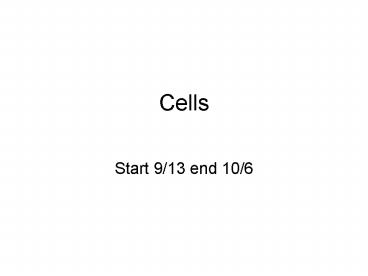Cells - PowerPoint PPT Presentation
1 / 10
Title:
Cells
Description:
formed by golgi bodies. contains digestive enzymes. enzymes breakdown ... golgi apparatus/bodies. processing center (packaging & secreting) stacks of membranes ... – PowerPoint PPT presentation
Number of Views:17
Avg rating:3.0/5.0
Title: Cells
1
Cells
- Start 9/13 end 10/6
2
THE HISTORY OF THE CELL Cells Building block of
living things Smallest unit capable of life
function too small to see with the naked eye many
times smaller than a grain of sand Role of the
microscope with cells After the invention of the
microscope in mid 1600's Grew with the
advancement microscope technology Light
microscope allows us to view up to 2000 times
see many cell structures of plants and
animals Transmission electron microscope (TEM)
allows us to 1000 times stronger than the light
microscope Scanning electron microscope (SEM)
allows us to Produces three-dimensional
images See the smallest cells with clear and
defined detail
3
- Time line of the cell
- 1600's -- compound microscope
- 1665 -- Robert Hooke saw cells in cork named
them cells - 1675 -- Anton van Leeuwenhoek lst saw movement
of organisms named them animals - -- Schleidan -plants were composed of cells
- -- Schwann - animals were composed of cells
- -- Virchow - cells come from existing cells
- CELL THEORY
- Observations of Schleiden, Schwann and Virchow
formed the Cell Theory. - The Cell Theory states
- 1. All living things are composed of one or more
cells. - 2. In organisms, cells are the basic units of
structure and function. - 3. Cells are produced only from existing cells.
4
- cytoplasm
- gel-like fluid within cell
- all processes occur here
- Holds organelles
- cell membrane
- outer covering
- holds together cell
- protects contents
- gives cell shape
- regulates passage (selectively permeable)
- Nucleus
- command center
- holds genetic chromosomes
- chromosomes
- hereditary related activities (DNA)
- ability to make proteins
- nucleolus
- Where ribosomes (which make proteins) are made
5
- cytoskeleton
- consists of microtubules microfiliaments
- composed of proteins
- form centrioles (help in cell division)
- cilia flagella
- extend out from cell
- used to move cell or move harmful substances away
from cell - mitochondria
- powerhouse (makes energy for the cell)
- has 2 membranes
- inner membrane has many folds to increase surface
area - produces ATP
- has own DNA
- found in large s in cells that require lots of
energy
6
- lysosome
- formed by golgi bodies
- contains digestive enzymes
- enzymes breakdown macromolecules
- digest recycle cell's used components
- peroxisome
- formed by smooth er
- contains enzymes
- convert fats to carbohydrates
- can break down toxic chemicals
- Ribosomes
- proteins are made
- most numerous organelle
- free floating or attached
- to endoplasmic reticulum
endoplasmic reticulum (er) membrane system of
sacs tunnels transportation system for
molecules Stores proteins rough er covered with
ribosomes smooth er not covered with
ribosomes golgi apparatus/bodies processing
center (packaging secreting) stacks of
membranes movement of proteins
7
- Plant cells have 5 structures that animal cells
do not - 1) Cell wall
- Supports/protects cell
- Made from cellulose
- Has pores
- 2) Vacuoles
- Stores enzymes and waste products
- Very large (like lysosome)
- 3)Chloroplasts
- Green pigment
- Absorbs sunlight (turns into food)
- 4) Chromoplasts
- Synthesizes and stores pigments
- Pigments like yellow/orange
- 5) Leucoplasts
- Stores food (starches, proteins, lipids)
Plastids are chloroplasts, chromosplasts, and
leucoplasts.storage
8
2 ways to maintain homeostasis 1) Passive
Transport Movement of any substance through a
cells membrane Does not require the use of
cellular energy Diffusion, Osmosis 2) Active
Transport Movement of any substance through a
cells membrane Does require the use of cellular
energy Proton Pump, Na-K Pump, Endocytosis
(pinocytosis, phagocytosis), Exocytosis Passive
Transport 1) Diffusion Process by which molecules
spread Area of higher concentration to area of
lower concentration Equilibrium When the
concentration of the molecules of a substance is
the same throughout
9
- Solute
- Substance that dissolves in another
- Ex. Sugars, amino acids, ions, etc.
- Solvent
- More plentiful substance that dissolves the
- solute
- Ex. In cells, water.
- Solution
- Mixture of solutes and solvents
- Ex. Cool-Aid
3 Types of Solutions (Book Page
60) Isotonic concentration of solutes outside
concentration of solutes inside (Ex. Most of our
body cells) Hypotonic Concentration of solutes
outside lt concentration of solutes inside Water
will move into the cell Water creates osmotic
pressure Pressure that results from osmosis If an
animal is placed in this solution it will
burst Plant cells can withstand high osmotic
pressure Hypertonic Concentration of solutes
outside gt concentration of solutes inside Causes
water to move out of the cell Cells Shrivel up,
Plants wilt Reason why drinking oceanic salt
water is dangerous
10
- Osmosis
- Diffusion of water molecules through a membrane
- Direction of higher concentration
- No control over osmosis
- 75 of this is water
- Water will move in and out of the cell until it
reaches equilibrium































